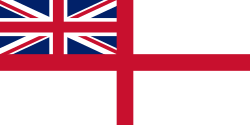Hydrographer of the Navy
Key United Kingdom military science post From Wikipedia, the free encyclopedia
The Hydrographer of the Navy is the principal hydrographical Royal Naval appointment. From 1795 until 2001, the post was responsible for the production of charts for the Royal Navy, and around this post grew the United Kingdom Hydrographic Office (UKHO).
| Hydrographer of the Navy | |
|---|---|
 | |
Incumbent since 2023Rear Admiral Angus Essenhigh | |
| Ministry of Defence | |
| Reports to | First Sea Lord |
| Nominator | Admiralty Board |
| Appointer | Secretary of State for Defence |
| Term length | 1–4 years |
| Inaugural holder | Alexander Dalrymple |
| Formation | 12 August 1795 |
In 2001, the post was disassociated from UKHO, and the Hydrographer of the Navy is now a title bestowed upon the current captain—hydrography and meteorology—on the staff of the Devonport Flotilla at HMNB Devonport.
History
Summarize
Perspective
Before the establishment of the post, captains of Royal Navy ships were responsible for the provision of their own charts. In practice this meant that ships often sailed with inadequate information for safe navigation, and that when new areas were surveyed, the data rarely reached all those who needed it. The Admiralty appointed Alexander Dalrymple as hydrographer on 12 August 1795, with a remit to gather and distribute charts to HM Ships. Within a year existing charts had been collated, and the first catalogue published. It was five years before the first chart—of Quiberon Bay in Brittany—was produced by the Hydrographer.[1]
Under Dalrymple's successor, Captain Thomas Hurd, Admiralty charts were sold to the general public, and by 1825, there were 736 charts listed in the catalogue. In 1829, the first Sailing Directions were published, and in 1833, under Rear-Admiral Sir Francis Beaufort—of the eponymous Beaufort scale—the tide tables were first published. Notices to Mariners came out in 1834, allowing for the timely correction of charts already in use. Beaufort was certainly responsible for a step change in output; by the time he left the office in 1855, the Hydrographic Office had a catalogue of nearly 2,000 charts and was producing over 130,000 charts, of which about half were provided to the Royal Navy and half sold.[1]
In 1939, on the outbreak of World War II, the Hydrographic Office moved to Taunton, and the post of hydrographer moved with it. In 2001, a chief executive was appointed to run the United Kingdom Hydrographic Office as a profit-making agency of the British government, and at this time the roles of National Hydrographer and Hydrographer of the Navy were divided.[1] The title of hydrographer devolved to Captain (hydrography and meteorology), a senior officer on the staff of the Commodore of the Devonport Flotilla, and the senior Royal Navy officer within the HM branch. As of 2010[update], the post has been renamed Captain (HM Ops), but continues to carry the title Hydrographer of the Navy.
List of hydrographers
- 1795–1808: Alexander Dalrymple FRS
- 1808–1823: Captain Thomas Hurd
- 1823–1829: Rear Admiral Sir Edward Parry FRS
- 1829–1855: Rear Admiral Sir Francis Beaufort KCB FRS FRGS FRAS MRIA
- 1855–1863: Rear Admiral John Washington FRS FRGS
- 1863–1874: Vice Admiral Sir George Richards KCB FRS
- 1874–1884: Captain Sir Frederick Evans KCB FRS FRAS FRGS
- 1884–1904: Rear Admiral Sir William Wharton KCB FRS FGS
- 1904–1909: Rear Admiral Sir Arthur Mostyn Field KCB FRS FRGS FRAS
- 1909–1914: Rear Admiral Sir Herbert Purey-Cust
- 1914–1919: Rear Admiral Sir John Parry
- 1919–1924: Vice Admiral Sir Frederick Learmonth
- 1924–1932: Vice Admiral Sir Percy Douglas KCB CMG FRGS FRAS AMICE
- 1932–1945: Vice Admiral Sir John Edgell
- 1945–1950: Rear Admiral Arthur Norris Wyatt
- 1950–1955: Vice Admiral Sir Archibald Day
- 1955–1960: Rear Admiral Kenneth Collins
- 1960–1966: Rear Admiral Sir Edmund Irving KBE CB FRGS
- 1966–1971: Rear Admiral Steve Ritchie CB
- 1971–1975: Rear Admiral Geoffrey Hall
- 1975–1985: Rear Admiral Sir David Haslam KBE CB
- 1985–1990: Rear Admiral Roger Morris
- 1990–1994: Rear Admiral John Myres
- 1994–1996: Rear Admiral Sir Nigel Essenhigh GCB
- 1996–2001: Rear Admiral John Clarke
- 2001–2003: Captain Mike Barritt
- 2003–2005: Captain David Lye
- 2005–2007: Captain Ian Turner
- 2007–2010: Captain Robert Stewart
- 2010–2012: Captain Vaughan Nail
- 2012–2013: Captain Stephen Malcolm
- 2013–2016: Captain David Robertson
- 2016–2017: Captain Matt Syrett
- 2017–2019: Captain Gary Hesling
- 2019–2021: Captain Derek Rae
- 2021–2023: Commander Mathew J Warren
- 2023-: Rear Admiral Angus Essenhigh OBE
Notes
References
External links
Wikiwand - on
Seamless Wikipedia browsing. On steroids.
